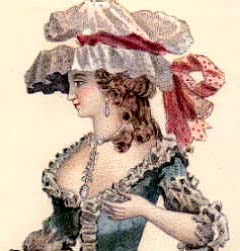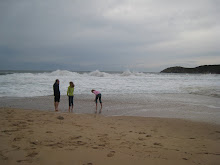But back to Thanksgiving. A. was still here when C. began working on the guest list, and in her helpful way she asked where we would get a turkey. I realized that I had no idea, aucune idee, where to find a turkey. I had never seen one in the poultry section of any of the grocery stores where I shop. I don't go into butcher shops very often, but I realized, after thinking for a moment or two, that I could not remember seeing a turkey in any of them. No turkeys were ever advertised as being on special; the most evidence of turkey that I had ever seen was the occasional package of escalope de dinde in the poultry section. An almost endless variety of chickens, large, small and medium, male and female: but never a turkey.
Yet it was our intention to have a full American Thanksgiving. L. and G. were coming from Paris, and bringing us cranberry sauce, canned pumpkin puree, and (not without some guilt and ambivalence on my part, but to E. and G.'s complete delight) a bag of marshmallows to put on the sweet potato pudding. And so I would have to find a turkey.
On a cold morning two weeks before Thanksgiving I ventured in to our local butcher shop. I had bought a roasted chicken or two there before--most recently, I had bought a roasted chicken in the evening that had been roasted in the morning, and my willingness to do so baffled the butcher, who seemed to take it both as a personal favor to him (buying chicken that was not moments off of the rotisserie!) and to find it deeply puzzling (why would Madame buy a chicken left over from this morning's roasting?)--but I was far from being a regular, a cliente. The shop was empty when I went in. Chickens were roasting, quiches and tartes were arranged on the top of the meat case, and the case itself was full of an elaborate and bloody assortment of cuts of beef, lamb, veal, rabbit arrayed in carnivorous glory.
I asked for some chicken breasts and, while the butcher was wrapping them, I ventured my request. I would like to order a turkey, if that's possible.
Ah. Vous faites le Thanksgiving americain. You are making American Thanksgiving. The butcher smiled and wiped his hands on his apron.
I smiled back, encouraged. Can you get turkeys for Thanksgiving?
But of course. A woman in Valbonne ordered one the other day. It is what you always eat for Thanksgiving, no? Turkey farcis? Stuffed turkey?
Yes, yes. We will be 12 people; can you get me a turkey the right size for that many people?
We conferred a bit about what the right size was, and when I should pick it up, and he took my name and phone number. I had one last request.
When you prepare the turkey, Monsieur, can you make it very clean? The roast chicken I had bought recently had come with shins attached. Did you know that chickens have shins? They do. In a rare moment of courage, I had snapped the roasted shins off of the legs before I carved the bird and before anyone else in the household could see them and decide to commence vegetarianism that night. However, I did not trust myself to be able to come to terms with turkey shins, or feet, or any other parts of the turkey never reproduced as a Normal Rockwell illustration of Thanksgiving.
The butcher looked quizzically at me. I tried to explain: no gizzards, no organs, no shins, but my French failed me. I fell back on foreignness. Could you, Monsieur, prepare the turkey as though it was for an American lady?
Now he nodded. Do not worry, Madame. It will be all clean.
The day before we were to make our Thanksgiving americain, L. and I went to pick up the turkey. The shop was busy; two butchers were on duty, the one from whom I had bought the chicken with shins and the one who had taken my turkey order. The turkey order man was attending to three ladies of a certain age. The ladies were turned out in sunglasses, leopard prints, sleek black suits, heels, and gloves; they looked like they had just been transported from one of the more fashionable shopping streets on the Right Bank. They were ordering an assortment of items for lunch.
Meanwhile, the chicken shins butcher turned to us. I explained that I had ordered a turkey. Ah! Une belle dinde! He smiled, glad that this time I was not settling for a leftover chicken. A pretty turkey! He rubbed his hands together and went behind the counter, where he opened a large door. I had seen that door, of course, but had never wondered what was behind it, in the same way, I imagine, that we Americans can look at a piece of meat on white styrofoam wrapped in plastic and not wonder where it came from. Well, wonder no more. The door opened to reveal a walk-in meat locker easily half the size again of the shop itself. Entire sides of beef hung from hooks in the ceiling. L. and I both drew back a half step.
Three turkeys hung from hooks across from the sides of beef. Our butcher took the first one and brought it out into the shop to weigh it. It was a little feathery and--how does one say this?--obviously quite fresh. Perhaps the best way to describe it is to describe something else in its place: a turkey from an American supermarket, for instance. What I have always unwrapped, or asked someone else to unwrap for me, on the kitchen counter on Thanksgiving morning, has been a white, white bird. If there were organs, they were neatly wrapped in waxed paper in the cavity of the bird. No feathers. No suggestion that this creature walked around recently, and no suggestion, either, of what it might have walked around on. The turkey that the butcher happily began to wrap up for us looked like it had probably enjoyed a hearty supper the night before.
That's not her turkey; someone's already bought that turkey, the other butcher interrupted him. Go get one of the other turkeys for her.
Our butcher shrugged and went back in the meat locker. Meanwhile, the leopard ladies were still ordering. We'll take some slices of roast beef; it's rare, isn't it?
Their butcher took a slab of roast beef the size of his forearm out of the case. With an immense knife, he shaved off a few deep pink slices.
And some of these beignets, these little doughnuts. They're so good with coffee. The taller leopard lady turned to the shorter one and they bobbed their heads at each other confidentially.
Their butcher wrapped the roast beef in paper and reached up to the top of the counter for a handful of beignets. There was no intermediate step: wrap the bloody beef, pick up the beignets.
Our butcher emerged from the meat locker with a second turkey. This one was a few grams smaller and had fewer feathers. The leopard ladies went off with their bloody roast beef and beignets, and our butcher wrapped and bagged the turkey--5 kilos and change--and handed over the bill with a flourish: Ca fait 79 euros, s'il vous plait, Madame.
In years past I have hesitated, as I stood at the turkey desk in Whole Foods, over whether to order the organic, free-range, baptised turkey at $3.47 per pound or to order instead the slightly less well-cared for bird at $2.50 per pound. Those days are gone. Thirty, forty dollars for a turkey? I will scoff at Thanksgiving tables in the future. Why, I remember the year I paid over a hundred dollars for a turkey in France.
It was a good turkey, though. It tasted different from the Butterballs of my childhood, and from the organic Toms of the past few years, a stronger taste, a turkier taste. We were pretty sure, L. and C. and I, that this turkey had not been injected with anything, and we could see for ourselves that there had been no chemical solvents, unless you count water, involved in preparing it for sale. And, though I'm sure the butchers and the turkey farmer are not going hungry, I don't think there was a whole lot of profit injected into the price. There are fewer people wanting turkeys, and fewer turkeys to be had, so turkeys cost more. (A lot more.)
The distance between production and consumption is shorter, and is not shrink-wrapped. Feathers and blood are a part of life and death, and eating beignets that have been close to roast beef juices probably won't kill you or even make you sick. (At least if you don't think about it too much.)
Nevertheless, I think we'll give turkey a miss for Christmas. Lobster might be cheaper.






































No comments:
Post a Comment